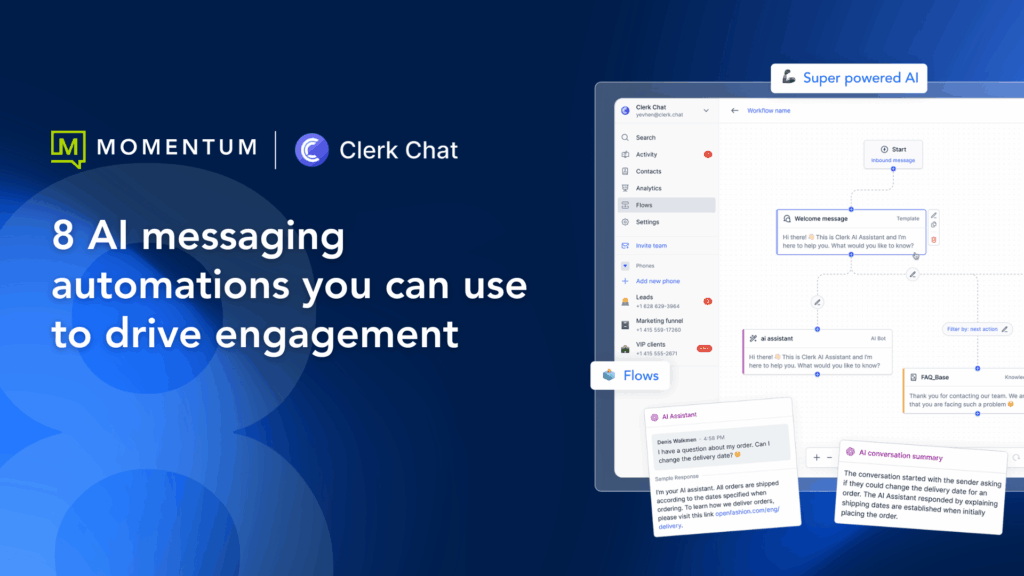How can we ensure a smooth port? That’s the one question we get asked all the time, and for good reason.
Porting may seem hard if you’re not familiar with the process. But with the right information and approach, it can be fairly straightforward.
We asked our porting specialists to come up with five easy tips to guarantee a smooth port—whether it’s to Momentum or not.
1. Know the Acronyms
Acronyms and telecommunications technology go hand in hand. Regardless of your provider, there are specific terms you will need to get familiar with.
Here are a few examples of the more popular acronyms you will encounter:
- Firm Order Commit Date (FOC): The date that the current or losing carrier allows you to take the telephone numbers
- Bill Telephone Number (BTN): The 10-digit telephone number for which you are billed for services.
- Customer Service Request/Record (CSR): A request from a customer’s authorized representative that starts a service action that has been confirmed as a normal part of service delivery.
- Local Number Portability (LNP): This confirms that your new carrier covers the area that your old carrier is in.

- Local Service Request (LSR): The order that the winning carrier submits to the losing carrier.
- Letter of Authorization (LOA): An agreement the new carrier will have you sign.
- Caller Name Information (CNAM): When you have phone numbers put on a new network, and a customer calls out, the CNAM is what the caller name says. Caller ID is the phone number, while CNAM is the actual name associated with that number.
- Directory Listing: These are the numbers that are recorded in the phone book.
It’s important to know the acronyms associated with the port transition so you’ll have an idea of what’s going on behind the scenes. Your winning carrier should run these details by you and help you understand them, but getting ahead of them is always a great idea.
2. Know Your Correct Account Information
Knowing your account information is extremely important. Having accurate information is the starting point for a seamless porting experience.
Any critical information like your address, company name, and other similar details must be accurate. If they are misspelled or incorrect, your port will be rejected.
Here are a few things to keep in mind:
- Authorize the person performing the port. An authorized party is the individual responsible for making changes to the account with the losing carrier. They will also need to ensure they have the right Billing Telephone Number (BTN) associated with the account and the correct telephone numbers for that same account.
- Ensure account passwords are known or removed (whenever possible). Customer service representatives will ask for any passwords associated with an account. Your authorized party must memorize them—otherwise, the port will be rejected, and the account may get locked.
- Verify no Primary Interexchange Carrier (PIC) freezes exist. These are used for changing long-distance carriers—or Local Number Portability (LNP) freezes on your account.
The biggest takeaway is to be prepared and comfortable answering questions about specific account details.
3. Identify Your Ideal Porting Date
The date that we request typically ends up being the Firm Order Commitment (FOC) date. Make sure that the date you request is the date that you want the telephone numbers.
It’s important to have this set accurately to prevent additional costs and wasted time since you’d have to start this process all over again. Do not deviate from your set date.
4. Verify No Pending Orders Are Associated With Your Account
Picture this: A customer signs up with you for a new service. They call their old carrier to cancel and proceed to order a disconnect.
That disconnect locks their current account.
There are several different types of orders, including:
- Change Orders
- Record Orders
- Disconnect Orders
- Transfer Orders

No pending orders can be submitted with the same Billing Telephone Number (BTN) and account number. If this happens, and your network attempts to port a new telephone number, that port will be rejected, replacing your date and forcing you to cancel your previous, pending order.
Take the time to double-check that there are no pending orders associated with your account.
5. Understand How The Port Will Be Transitioned
Understanding how the porting process works will ensure a seamless transition that follows your established timelines.
Choose whether your port will be transitioned automatically or manually. At Momentum, we do automatic transitions. For instance, if numbers are porting at 8 a.m. on a Friday morning, your numbers are likely to be fully ported by 8:02 a.m. It’s wise to keep an eye on this to confirm your porting success.
Need Porting Support? Momentum Can Help
You now understand what it takes to ensure a quick and easy transition to a new carrier, no matter which network you choose.
Momentum specializes in cloud communications, and SIP trunking, and traditional telephony solutions, providing reliable services and support through every step of the process.
Looking for help with your next port? Get in touch with one of our porting specialists today to get started.



